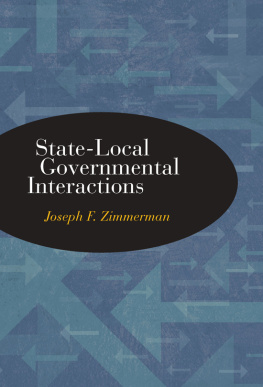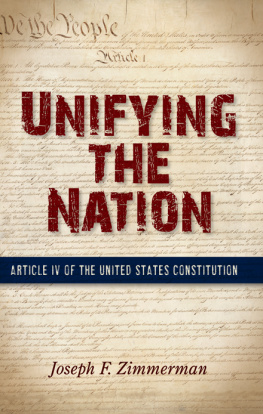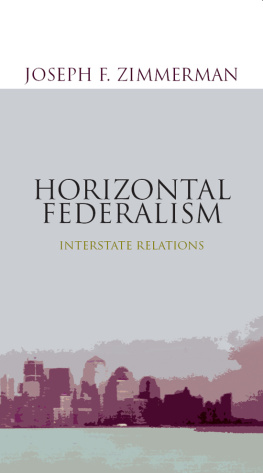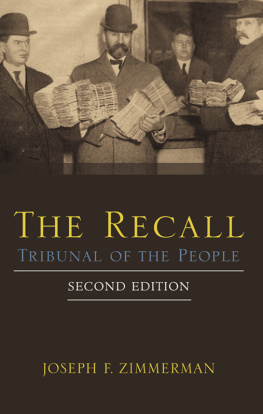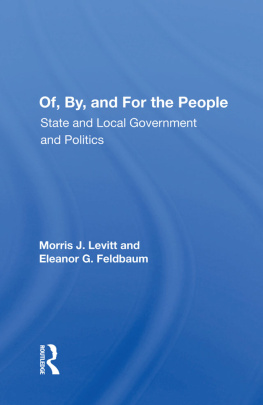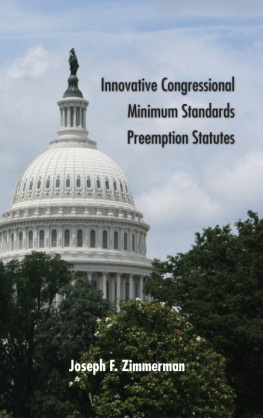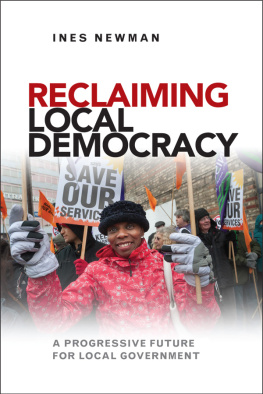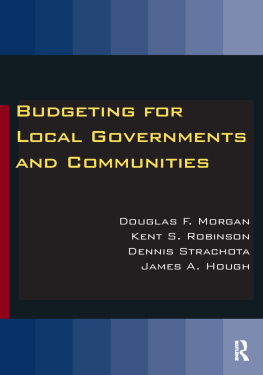State-Local Governmental Interactions
Joseph F.Zimmerman
Published by State University of New York Press, Albany
2012 State University of New York
All rights reserved
Printed in the United States of America
No part of this book may be used or reproduced in any manner whatsoever without written permission. No part of this book may be stored in a retrieval system or transmitted in any form or by any means including electronic, electrostatic, magnetic tape, mechanical, photocopying, recording, or otherwise without the prior permission in writing of the publisher.
For information, contact State University of New York Press, Albany, NY
www.sunypress.edu
Production by Ryan Morris
Marketing by Michael Campochiaro
Library of Congress Cataloging-in-Publication Data
Zimmerman, Joseph Francis, 1928
State-local governmental interactions / Joseph F. Zimmerman.
p. cm.
Includes bibliographical references and index.
ISBN 978-1-4384-4169-6 (hardcover : alk. paper)
1. State-local relationsUnited States. 2. Intergovernmental fiscal relationsUnited States.
3. Intergovernmental cooperationUnited States I. Title.
JS348.Z56 2012
320.80973dc23
2011018383
10 9 8 7 6 5 4 3 2 1
For Peggy with love, in appreciation for her continuing support
Preface
State and local governments provide all services, except the postal service, to citizens residing in states, and engage in regulatory activities in multitudinous areas. Nevertheless, the interactions between state governments and their political subdivisions are among the most neglected areas of the literature on governance in the United States. The neglect in part is attributable to the great diversity in such interactions within the typical state as well as between states.
A review of the book's bibliography reveals the relative dearth of recent literature on the subject of state-local governmental interactions. Numerous books and journal articles were published in the immediate postWorld War II period, but their number started to decline by the early 1980s. As a consequence, the author had to collect directly up-to-date data and information on most of the subjects addressed in the book.
This book expands the scope of earlier studies conducted by the author for the U.S. Advisory Commission on Intergovernmental Relations. The studies deal with intergovernmental service agreements, transfers of functional responsibility, state and federal mandates, and the discretionary authority of general-purpose local governments. The last of these studies produced the first index of local discretionary authority for each type of general-purpose local government in each state.
All states initially used the English common law's Ultra Vires Rule, positing that local governments may exercise only powers specifically devolved on them. In other words, local governments lack sovereign powers. Several governmental reform movements arose in the latter part of the nineteenth century, and achieved considerable success in eliminating or reducing governmental corruption, and broadening the discretionary authority of general-purpose local governments in certain states.
Reformers in recent decades also have achieved success in a number of states, by constitutional amendments and statutes, in broadening the powers of general-purpose local governments. However, state legislatures and Congress simultaneously imposed on local governments mandates and restraints, including federal ones that have major compliance costs threatening to bankrupt many small local governments unless relief is provided. The costs of the mandates consume funds that otherwise could be employed by local governments for discretionary purposes. The mandates and constitutional and statutory provisions providing mandate relief are examined in this volume.
Major controversies in several states continue to revolve around the question of the best approach to granting local discretionary authority and the role of the judiciary as the referee of legal conflicts between states and their political subdivisions. One purpose of this volume is to present a model of state-local relations that will produce broad discretionary authority for local governments and a partnership approach between each state government and its political subdivisions for the solution of public problems at the lowest cost to taxpayers.
Acknowledgments
A book on numerous and complex state-local governmental interactions in the fifty states is not based solely on the research of one author. Preparation of the manuscript was assisted greatly by the published research of others, and the responses by governmental experts in the fifty states to my requests for specific information and general trends in such interactions in each state.
I acknowledge a debt of gratitude to copy editor Laura Glenn for assistance in improving the manuscript, and a major debt of gratitude to Addie Napolitano for her expert preparation of this manuscript and other manuscripts for publication.
Chapter 1
State Governments and Their Political Subdivisions
Local governments are the most common form of government in the United States, provide most public services on a daily basis to their respective citizens, and are major regulators of business firms and individuals. The 2007 census of governments reveals that there were 89,476 local governments: 3,033 counties; 19,492 municipalities; 16,519 towns and townships; 37,381 special districts; and 13,051 independent school districts. These units were governed by approximately 500,000 elected officers supported by approximately 12.1 million full-time equivalent employees, a 5.5 percent increase since 2002. These governmental units vary from Lilliputian ones with a population under fifty to New York City with a population of approximately 9 million.
Public opinion polls consistently reveal that interviewees are convinced local governments provide the most benefits for taxpayers' money and spend it wisely. Public confidence in local governments has been increasing in sharp contrast to citizens' exceptionally low confidence in the federal government. Citizen confidence in local governments dates to the New England open town-meeting where voters assemble and make all decisions. This meeting originated in the Massachusetts Bay Colony in 1630, and is the only example of pure or direct assembled democracy in the United States. contains a brief examination of Massachusetts historical records that is most revealing with respect to the suggested grassroots tradition of local self-governance.
The replacement of the British rule by state governments did not change dramatically the discretionary authority of local governments as the new governments continued to employ the English common law and its Ultra Vires Rule positing that a local government may exercise only the powers devolved on it by the state legislature. Tight legislative control of local governments, including ripper laws tearing apart a local government, generated a debate over whether state dominance should be replaced by constitutionally protected local autonomy. The so-called home rule movement in the latter decades of the nineteenth century achieved some of its goals of broadening the discretionary authority of general-purpose local governments in a number of states, and other home-rule gains were made in some but not all of the states in the twentieth century.
Two competing theories with respect to the most desirable degree of concentration of political power influenced the legal nature of state-local relations in the United States. One paradigm stresses the integration of political authority and the other supports the fragmentation of such authority. Some observers view the clash as one between elitist theory and democratic theory. A brief examination of key provisions of the U.S. Constitution will facilitate an understanding of the powers a state legislature may exercise relative to local governments.


